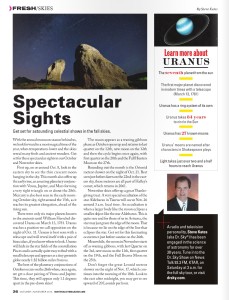Get set for celestial shows in the fall Arizona skies
Get set for astounding celestial shows in the fall Arizona skies
By Steve Kates
With the annual monsoon season behind us, we look forward to a most magical time of the year, when temperatures lower and the skies reveal many fresh and ancient wonders. Get set for these spectacular sights in our October and November skies.
First up, on or around Oct. 8, look to the eastern sky to see the thin crescent moon hanging in the sky. This month also offers up the early riser, an amazing planetary conjunction with Venus, Jupiter, and Mars forming a very tight triangle on or about the 28th. Mercury is also best seen in the early morning October sky, right around the 15th, as it reaches its greatest elongation, ahead of the rising sun.
There were only six major planets known to the ancients until William Herschel discovered Uranus on March 13, 1781. Uranus reaches a position we call opposition on the night of Oct. 11. Uranus is best seen with a telescope and will reveal itself with a pair of binoculars, if you know where to look. Uranus will hide in the star fields of the constellation Pisces and is actually quite easy to find with a small telescope and appears as a tiny greenish globe nearly 1.82 billion miles from us.
The best of the planetary conjunctions of October occurs on the 26th when, once again, we get a close pairing of Venus and Jupiter. This time, they will appear only 1.1 degrees apart in the pre-dawn skies!
The moon appears as a waning gibbous phase as October opens up and returns to last quarter on the 12th, new moon on the 12th and then the cycle begins once again, with first quarter on the 20th and the Full Hunters Moon on the 27th.
Rounding out the month is the Orionid meteor shower on the night of Oct. 21. Best seen just before dawn on the 22nd in the eastern sky, these meteors are all part of Halley’s comet, which returns in 2061.
November skies offer up a great Thanksgiving treat. A very special occultation of the star Aldebaran in Taurus will occur Nov. 26 around 3 a.m. local time. An occultation is when a larger body like the moon eclipses a smaller object like the star Aldebaran.This is quite rare and for those of us in Arizona, the star may just graze the edge of the moon. That is because we lie on the edge of the line that eclipses the star. Get set for this fascinating occurrence just before sunrise on the 26th.
Meanwhile, the moon in November starts off as waning gibbous, with last Quarter on the 3rd, new moon on the 11th, first quarter on the 19th, and the Full Beaver Moon on the 25th.
Don’t forget the great Leonid meteor shower on the night of Nov. 17, which continues into the morning of the 18th. Look to the east after midnight, you may get to see upward of 20 Leonids per hour.
Learn more about Uranus
- The seventh planet from the sun
- The first major planet discovered in modern times with a telescope (March 13, 1781)
- Uranus has a ring system of its own
- Uranus takes 84 years to circle the Sun
- Uranus has 27 known moons
The lowdown on October and November meteor showers
Humans have seen the Orionid meteor shower since ancient times
The Orionid meteors are debris from Halley’s comet
Orioinid meteors travel at speeds of 40 miles per second!
The Leonid meteor shower of 1833 was a “storm” and many thought it was the end of the world!
President Abraham Lincoln observed the Leonids in 1833 in Illinois
Related posts
Leave a Comment
You must be logged in to post a comment.







